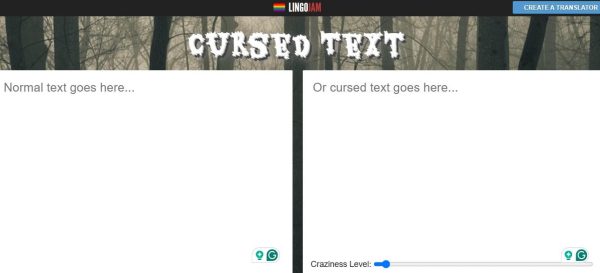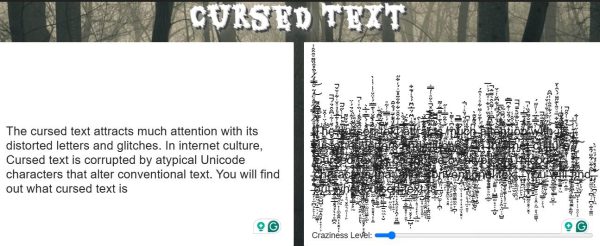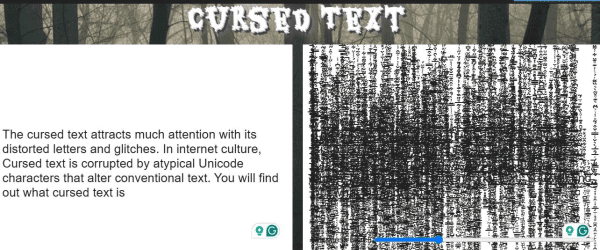The cursed text really attracts much attention with its distorted letters and glitches. In internet culture cursed text is corrupted by atypical Unicode characters that alter conventional text. You will find out what cursed text is and why users find it to be exciting and how users can exploit it without descending into madness here. This is also a guide on how parents will be able to identify and control the usage of cursed words on their kids. These things can cause harm to kids to an extent you cannot imagine, so taking care of your kids is of the utmost importance. At the end of the day, you will learn how to enjoy cursed text curiously be it sharing memes or advice to young users.
What is cursed text?
Cursed text is basically a distorted or glitched writing created using special Unicode characters. This is often used online to create a creepy, chaotic, or eerie effect in memes, messages, and usernames. Such a cursed text is done with peculiar characters and supplementary diacritical signs that cause words to appear glitchy or spooky or simply illegible. The method is based on the use of standard letters and combining diacritics, which are small marks that are usually positioned on top or at the bottom of letters. And when you layer several combining marks, encroachments upon themselves and one another are comprehensive and bleed together. That gives a dizzying effect which would cause people to refer to it as being cursed.
Artists use the cursed text to bring surrealism to chat messages, social media posts, or online artworks. It adds the element of humor and absurdity when one is keen on shocking or entertaining people.
In gamer forums and Discord servers, cursed text is often used as a funny inside joke that only players or friends in the group fully understand. When a person reacts by sending cursed text, he communicates his belonging to a subculture that appreciates trolls, memes, and horror aesthetics.
As a piece of art, cursed text blazes on promo banners, text in digital art, and creepy narration on social media, such as Tumblr. You may add colored text or an animated GIF over it to make the effect stronger. Nevertheless, its overuse will overpower the readers and might cause screen readers or access tools to read something unprofessionally. Apply cursed text in moderation: counter it with readable blocks, preview on many similar devices, and make sure it does not obstruct critical texts, particularly in the case of a distribution to younger users.
How does cursed text differ from regular text?
Normal text uses ordinary letter forms and spacing, thus it is easy to read at a glance. Cursed text trammels that by inserting additional symbols or reversing characters. You may even notice pages full of letters with diacritics above and below or words changed into some unknown Unicode characters. The effect of that manipulation is a distorted, glitchy appearance that starkly contrasts with straight text. Whereas normal text is read easily, the cursed text jerks eyes off readers, making them read more slowly and read the words aloud. It seems random and uncontrollable, which is why it is gaining memes, horror entries, and trolling on the web.
Monitor and filter potentially harmful content effortlessly.
How to generate cursed texts?
LingoJam Cursed Text Generator
LingoJam’s Cursed Text Generator turns your plain phrases into creepy, glitched sequences by stacking Unicode diacritics. You type normal words into the left box and watch as the tool composes limitless combining marks to produce eerie, overlapping characters. You copy and paste the result into chats, comments, or social posts to simulate a “hacked” appearance. It relies on standard Unicode rules, so it works across most platforms until sites strip excess marks.
Step-by-step with LingoJam cursed text generator
First, open LingoJam Cursed Text.



In the left-hand box, type the words you want to distort.
The right-hand box updates instantly with multiple cursed variations.



Then, use the slider below “Craziness bar” for the input box to increase or decrease diacritic stacking. Slide right for maximum “curse.”



Copy and paste – Highlight your favorite output, press Ctrl+C (or tap Copy), then paste it into your post or chat.
Preview on your target platform. Some social networks strip excess diacritics or reformat Unicode. Adjust intensity as needed.
Glyphy
Glyphy offers over 400 decorative fonts and more than 10,000 symbols and emoticons that you can copy and paste into your Instagram, Discord, Twitter, Facebook, or TikTok profiles. It features a Font Generator, Cool Symbols, Name Generator, and Emoticons Maker, each letting you preview live and instantly grab styled text. You don’t need an account; simply type your phrase and select a style to enhance any social or gaming ID.
Zalgo Text Generator
LingoJam’s Zalgo Text Generator lets you wrap ordinary text into creepy “Zalgo” distortions. You enter your message, then drag the “craziness level” slider to control how many diacritics appear above, below, or through each letter. The underlying engine, built by combatwombat, composes these marks in real time. You copy the output and paste it into posts, chat bubbles, or document headers for a chilling glitch effect.
Messletters
Messletters.net transforms your plain text into eye‑catching, stylish fonts without requiring a sign‑up. You write your phrase in the input field and instantly browse multiple decorative options ranging from ornate letters to gaming‑style IDs and social‑media ready captions. The site traces its roots to MSN Letters, expanding today to support chat names on Skype, Facebook, and Twitter. You simply pick a design and copy it for immediate use.
Unicode Text Converter
Unicode Text Converter (textconverter.net) converts ASCII characters into a variety of Unicode alternatives that work seamlessly on Facebook, WhatsApp, Twitter (X), LinkedIn, and more. You type your original text into the left pane, and the tool instantly displays a one‑to‑one converted version across multiple styles. You preview until you find the right look, then copy and paste the result into messages, bios, or headlines without worrying about compatibility.
Where is cursed text used?
On social media
Kids and teens often post cursed text on TikTok captions, Twitter bios and Instagram stories. They use it to make jokes more dramatic or to add a creepy vibe to Halloween posts. A mildly cursed phrase in a tweet can spark retweets, while in an Instagram story it can grab viewers’ attention before they swipe.
In online communities and gaming
Discord servers, Reddit threads and gaming chats brim with cursed text. Players slap it into usernames or status messages to stand out during raids or tournaments. In forums like r/NoSleep, for example, cursed captions heighten horror stories. Twitch streamers overlay cursed chat text on-screen for comedic or spooky effects.
On personal websites and art
Digital artists embed cursed quotes in their portfolio sites. Bloggers use it to highlight spooky anecdotes. Even niche newsletters in fandom communities sprinkle cursed headers to maintain a playful tone.
In marketing and events
Some event organizers slip cursed text into promotional flyers for horror movie nights or escape rooms. It signals the theme instantly. Marketers use it in email subject lines to boost open rates, provided the text remains somewhat readable.
Why do kids use it?
When kids dig cursed text, it is all due to its feel of rebellion and fun. It provides their messages with some advantage and makes them somehow outstanding within a group chat or comment thread. They find amusement in fooling around with friends and the inventiveness of putting ordinary words together in weird artworks. On some other occasions they are encouraged to utilize the newest text hacks or generators due to peer pressure to raise their online credibility among others.
Are cursed texts safe to use?
Cursed text will not infect your device as the only thing it uses are bizarre Unicode characters but there can still be a problem when you go overboard. In case such screen readers are not capable of working with layers of diacritics, the blind audience could lose your message. Other social sites will remove or nullify characters that are extensively “cursed “, rendering your post damaged or unmanned.
If a browser or an older phone interprets your effect, they may end up displaying empty squares or gibberish rather than your effect. If you put excess distortion on one message, you are likely to frustrate readers, and thus, they just pass through it without reading. Children tend to hop on the bandwagon without understanding that it negatively attributes to accessibility and etiquette, so indicate to them that they should only test their doom text sparingly and offset it with clear and plain words.
How to ensure your kid’s online safety?
Modern parents should stay alert: kids encounter cursed text in chats, memes, and social apps. While often harmless fun, excess can lead to frustration or exposure to unsettling content. Parental control tools are something that every parent should be aware of and use accordingly to provide safety for their kids and monitor their online actions. A good tool like FlashGet Kids can basically serve as your ally in guiding safe use. It has features like:



- Set up alerts for “cursed text,” “Zalgo,” or other related terms. When these keywords appear in your child’s messages or searches, you’ll receive instant notifications.
- Mirror your child’s device screen to view their social media activity. You’ll spot if they share or interact with heavily distorted text.
- Block or limit access to online curse-text generators. You can prevent the installation or usage of LingoJam, Messletters, and similar tools.
- Allocate specific hours for creative messaging. This prevents late-night experimentation that might disrupt sleep or lead to anxiety.
- Review your child’s public posts together, offering guidance on striking a balance between fun and clarity.
Conclusion
Cursed text manipulates the Unicode of ordinary words to create exciting art that attracts interest. You have got the gist of its definition, have observed what makes it more than plain text, and have found out leading generators, such as LingoJam and Zalgo Text. Now you understand where children and artists are throwing it over social media, game chat rooms, and advertising odds and ends, and why it is so addictive to them.
We have covered safety and listed possibilities and threats to access and user experience, and demonstrated how parental controls such as FlashGet Kids can control and direct healthy use of them. Use cursed text wisely, whether you’re creating a meme to scare someone or helping your child learn to enjoy being creative in the digital space. Cross-check devices, tame the fun with clarity, and keep the audience in mind. Put to fair use, cursed text will always be a cheeky, innocuous gimmick, something that can never be frustrating or confusing.

